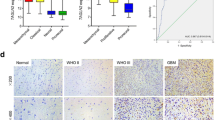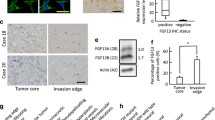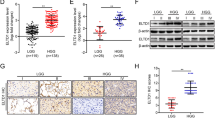Abstract
To identify molecular therapeutic targets for glioma, we performed gene expression profiling by using a complementary DNA (cDNA) microarray method and identified the urokinase plasminogen activator receptor-associated protein (uPARAP/Endo180) as a gene expressed highly in glioma tissue compared with the normal brain tissue. The uPARAP is an endocytic receptor for collagen. In certain cell types, uPARAP occurs in a complex with the urokinase plasminogen activator receptor (uPAR) where it fulfills other functions in addition to collagenolysis. Quantitative PCR analysis using a cDNA panel revealed higher expression levels of uPARAP in glioma tissue compared with normal brain tissue. Western blot analysis revealed that the uPARAP protein was expressed in glioma samples and two glioma cell lines, KNS42 and KNS81, but not expressed in control tissue from the normal brain. Introduction of small interfering RNA-targeted uPARAP into the two different glioma cell lines, KNS42 and KNS81, resulted in downregulation of uPARAP expression, and it significantly suppressed glioma cell migration and invasion in vitro. Control glioma cells showed small cell bodies, whereas uPARAP siRNA-treated glioma cells exhibited large and flat morphology. Most of the polymeric actin in the control glioma cells was concentrated in the lamellipodia that are observed in mobile cells. In contrast, in the uPARAP siRNA-treated glioma cells, polymeric actin became organized in stress fibers and the lamellipodia disappeared, characteristic of immobile cells. Our present study suggests that uPARAP may be involved in glioma cell invasiveness through actin cytoskeletal rearrangement. downregulation of uPARAP may be a novel anti-invasion therapeutic strategy for malignant gliomas.






Similar content being viewed by others
References
Prados MD, Levin V (2000) Biology and treatment of malignant glioma. Semin Oncol 27:1–10
Takahashi S, Hirose Y, Ikeda E, Fukaya R, Kawase T (2007) Chromosome arm 1q gain associated with good response to chemotherapy in a malignant glioma. Case report. J Neurosurg 106:488–494. doi:10.3171/jns.2007.106.3.488
DeRisi J, Penland L, Brown PO, Bittner ML, Meltzer PS, Ray M, Chen Y, Su YA, Trent JM (1996) Use of a cDNA microarray to analyse gene expression patterns in human cancer. Nat Genet 14:457–460. doi:10.1038/ng1296-457
Gill RW, Sanseau P (2000) Rapid in silico cloning of genes using expressed sequence tags (ESTs). Biotechnol Annu Rev 5:25–44
Lindlof A (2003) Gene identification through large-scale EST sequence processing. Appl Bioinformatics 2:123–129
Engelholm LH, Nielsen BS, Dano K, Behrendt N (2001) The urokinase receptor associated protein (uPARAP/endo180): a novel internalization receptor connected to the plasminogen activation system. Trends Cardiovasc Med 11:7–13
Sheikh H, Yarwood H, Ashworth A, Isacke CM (2000) Endo180, an endocytic recycling glycoprotein related to the macrophage mannose receptor is expressed on fibroblasts, endothelial cells and macrophages and functions as a lectin receptor. J Cell Sci 113(Pt 6):1021–1032
Behrendt N, Jensen ON, Engelholm LH, Mortz E, Mann M, Dano K (2000) A urokinase receptor-associated protein with specific collagen binding properties. J Biol Chem 275:1993–2002
Schnack Nielsen B, Rank F, Engelholm LH, Holm A, Dano K, Behrendt N (2002) Urokinase receptor-associated protein (uPARAP) is expressed in connection with malignant as well as benign lesions of the human breast and occurs in specific populations of stromal cells. Int J Cancer 98:656–664. doi:10.1002/ijc.10227
Sulek J, Wagenaar-Miller RA, Shireman J, Molinolo A, Madsen DH, Engelholm LH, Behrendt N, Bugge TH (2007) Increased expression of the collagen internalization receptor uPARAP/Endo180 in the stroma of head and neck cancer. J Histochem Cytochem 55:347–353. doi:10.1369/jhc.6A7133.2006
Kogianni G, Walker MM, Waxman J, Sturge J (2009) Endo180 expression with cofunctional partners MT1-MMP and uPAR-uPA is correlated with prostate cancer progression. Eur J Cancer 45:685–693. doi:10.1016/j.ejca.2008.11.023
Huijbers IJ, Iravani M, Popov S, Robertson D, Al-Sarraj S, Jones C, Isacke CM (2010) A role for fibrillar collagen deposition and the collagen internalization receptor endo180 in glioma invasion. PLoS One 5:e9808. doi:10.1371/journal.pone.0009808
Behrendt N (2004) The urokinase receptor (uPAR) and the uPAR-associated protein (uPARAP/Endo180): membrane proteins engaged in matrix turnover during tissue remodeling. Biol Chem 385:103–136. doi:10.1515/BC.2004.031
Wienke D, Davies GC, Johnson DA, Sturge J, Lambros MB, Savage K, Elsheikh SE, Green AR, Ellis IO, Robertson D, Reis-Filho JS, Isacke CM (2007) The collagen receptor Endo180 (CD280) is expressed on basal-like breast tumor cells and promotes tumor growth in vivo. Cancer Res 67:10230–10240. doi:10.1158/0008-5472.CAN-06-3496
Sturge J, Wienke D, East L, Jones GE, Isacke CM (2003) GPI-anchored uPAR requires Endo180 for rapid directional sensing during chemotaxis. J Cell Biol 162:789–794. doi:10.1083/jcb.200302124
Sturge J, Wienke D, Isacke CM (2006) Endosomes generate localized Rho-ROCK-MLC2-based contractile signals via Endo180 to promote adhesion disassembly. J Cell Biol 175:337–347. doi:10.1083/jcb.200602125
Wienke D, MacFadyen JR, Isacke CM (2003) Identification and characterization of the endocytic transmembrane glycoprotein Endo180 as a novel collagen receptor. Mol Biol Cell 14:3592–3604. doi:10.1091/mbc.E02-12-0814
Kjoller L, Engelholm LH, Hoyer-Hansen M, Dano K, Bugge TH, Behrendt N (2004) uPARAP/endo180 directs lysosomal delivery and degradation of collagen IV. Exp Cell Res 293:106–116
Engelholm LH, Ingvarsen S, Jurgensen HJ, Hillig T, Madsen DH, Nielsen BS, Behrendt N (2009) The collagen receptor uPARAP/Endo180. Front Biosci 14:2103–2114
Gondi CS, Lakka SS, Dinh DH, Olivero WC, Gujrati M, Rao JS (2004) Downregulation of uPA, uPAR and MMP-9 using small, interfering, hairpin RNA (siRNA) inhibits glioma cell invasion, angiogenesis and tumor growth. Neuron Glia Biol 1:165–176. doi:10.1017/s1740925x04000237
Kinder DH, Berger MS, Mueller BA, Silber JR (1993) Urokinase plasminogen activator is elevated in human astrocytic gliomas relative to normal adjacent brain. Oncol Res 5:409–414
Mohanam S, Sawaya R, McCutcheon I, Ali-Osman F, Boyd D, Rao JS (1993) Modulation of in vitro invasion of human glioblastoma cells by urokinase-type plasminogen activator receptor antibody. Cancer Res 53:4143–4147
Gondi CS, Lakka SS, Yanamandra N, Siddique K, Dinh DH, Olivero WC, Gujrati M, Rao JS (2003) Expression of antisense uPAR and antisense uPA from a bicistronic adenoviral construct inhibits glioma cell invasion, tumor growth, and angiogenesis. Oncogene 22:5967–5975. doi:10.1038/sj.onc.1206535
Zhao Y, Lyons CE Jr, Xiao A, Templeton DJ, Sang QA, Brew K, Hussaini IM (2008) Urokinase directly activates matrix metalloproteinases-9: a potential role in glioblastoma invasion. Biochem Biophys Res Commun 369:1215–1220. doi:10.1016/j.bbrc.2008.03.038
Mohanam S, Jasti SL, Kondraganti SR, Chandrasekar N, Kin Y, Fuller GN, Lakka SS, Kyritsis AP, Dinh DH, Olivero WC, Gujrati M, Yung WK, Rao JS (2001) Stable transfection of urokinase-type plasminogen activator antisense construct modulates invasion of human glioblastoma cells. Clin Cancer Res 7:2519–2526
Kunigal S, Gondi CS, Gujrati M, Lakka SS, Dinh DH, Olivero WC, Rao JS (2006) SPARC-induced migration of glioblastoma cell lines via uPA-uPAR signaling and activation of small GTPase RhoA. Int J Oncol 29:1349–1357
Chandrasekar N, Mohanam S, Gujrati M, Olivero WC, Dinh DH, Rao JS (2003) Downregulation of uPA inhibits migration and PI3 k/Akt signaling in glioblastoma cells. Oncogene 22:392–400. doi:10.1038/sj.onc.1206164
Gondi CS, Lakka SS, Dinh DH, Olivero WC, Gujrati M, Rao JS (2007) Intraperitoneal injection of a hairpin RNA-expressing plasmid targeting urokinase-type plasminogen activator (uPA) receptor and uPA retards angiogenesis and inhibits intracranial tumor growth in nude mice. Clin Cancer Res 13:4051–4060. doi:10.1158/1078-0432.CCR-06-3032
Go Y, Chintala SK, Mohanam S, Gokaslan Z, Venkaiah B, Bjerkvig R, Oka K, Nicolson GL, Sawaya R, Rao JS (1997) Inhibition of in vivo tumorigenicity and invasiveness of a human glioblastoma cell line transfected with antisense uPAR vectors. Clin Exp Metastasis 15:440–446
Mohanam S, Chintala SK, Go Y, Bhattacharya A, Venkaiah B, Boyd D, Gokaslan ZL, Sawaya R, Rao JS (1997) In vitro inhibition of human glioblastoma cell line invasiveness by antisense uPA receptor. Oncogene 14:1351–1359. doi:10.1038/sj.onc.1200963
Lakka SS, Gondi CS, Dinh DH, Olivero WC, Gujrati M, Rao VH, Sioka C, Rao JS (2005) Specific interference of urokinase-type plasminogen activator receptor and matrix metalloproteinase-9 gene expression induced by double-stranded RNA results in decreased invasion, tumor growth, and angiogenesis in gliomas. J Biol Chem 280:21882–21892. doi:10.1074/jbc.M408520200
Gondi CS, Lakka SS, Dinh DH, Olivero WC, Gujrati M, Rao JS (2004) RNAi-mediated inhibition of cathepsin B and uPAR leads to decreased cell invasion, angiogenesis and tumor growth in gliomas. Oncogene 23:8486–8496. doi:10.1038/sj.onc.1207879
Lakka SS, Gondi CS, Yanamandra N, Dinh DH, Olivero WC, Gujrati M, Rao JS (2003) Synergistic down-regulation of urokinase plasminogen activator receptor and matrix metalloproteinase-9 in SNB19 glioblastoma cells efficiently inhibits glioma cell invasion, angiogenesis, and tumor growth. Cancer Res 63:2454–2461
Mohan PM, Lakka SS, Mohanam S, Kin Y, Sawaya R, Kyritsis AP, Nicolson GL, Rao JS (1999) Downregulation of the urokinase-type plasminogen activator receptor through inhibition of translation by antisense oligonucleotide suppresses invasion of human glioblastoma cells. Clin Exp Metastasis 17:617–621
Mohan PM, Chintala SK, Mohanam S, Gladson CL, Kim ES, Gokaslan ZL, Lakka SS, Roth JA, Fang B, Sawaya R, Kyritsis AP, Rao JS (1999) Adenovirus-mediated delivery of antisense gene to urokinase-type plasminogen activator receptor suppresses glioma invasion and tumor growth. Cancer Res 59:3369–3373
Mohanam S, Go Y, Sawaya R, Venkaiah B, Mohan PM, Kouraklis GP, Gokaslan ZL, Lagos GK, Rao JS (1999) Elevated levels of urokinase-type plasminogen activator and its receptor during tumor growth in vivo. Int J Oncol 14:169–174
Gumbiner BM (1996) Cell adhesion: the molecular basis of tissue architecture and morphogenesis. Cell 84:345–357
Lauffenburger DA, Horwitz AF (1996) Cell migration: a physically integrated molecular process. Cell 84:359–369
Tabu K, Ohba Y, Suzuki T, Makino Y, Kimura T, Ohnishi A, Sakai M, Watanabe T, Tanaka S, Sawa H (2007) Oligodendrocyte lineage transcription factor 2 inhibits the motility of a human glial tumor cell line by activating RhoA. Mol Cancer Res 5:1099–1109. doi:10.1158/1541-7786.MCR-07-0096
Ren XD, Kiosses WB, Sieg DJ, Otey CA, Schlaepfer DD, Schwartz MA (2000) Focal adhesion kinase suppresses Rho activity to promote focal adhesion turnover. J Cell Sci 113(Pt 20):3673–3678
Arthur WT, Burridge K (2001) RhoA inactivation by p190RhoGAP regulates cell spreading and migration by promoting membrane protrusion and polarity. Mol Biol Cell 12:2711–2720
Cox EA, Sastry SK, Huttenlocher A (2001) Integrin-mediated adhesion regulates cell polarity and membrane protrusion through the Rho family of GTPases. Mol Biol Cell 12:265–277
Shiratsuchi A, Ichiki M, Okamoto Y, Ueda N, Sugimoto N, Takuwa Y, Nakanishi Y (2009) Inhibitory effect of N-palmitoylphosphatidylethanolamine on macrophage phagocytosis through inhibition of Rac1 and Cdc42. J Biochem 145:43–50. doi:10.1093/jb/mvn139
Vial E, Sahai E, Marshall CJ (2003) ERK-MAPK signaling coordinately regulates activity of Rac1 and RhoA for tumor cell motility. Cancer Cell 4:67–79
Ilic D, Furuta Y, Kanazawa S, Takeda N, Sobue K, Nakatsuji N, Nomura S, Fujimoto J, Okada M, Yamamoto T (1995) Reduced cell motility and enhanced focal adhesion contact formation in cells from FAK-deficient mice. Nature 377:539–544. doi:10.1038/377539a0
Kjoller L, Hall A (2001) Rac mediates cytoskeletal rearrangements and increased cell motility induced by urokinase-type plasminogen activator receptor binding to vitronectin. J Cell Biol 152:1145–1157
Goldberg L, Kloog Y (2006) A Ras inhibitor tilts the balance between Rac and Rho and blocks phosphatidylinositol 3-kinase-dependent glioblastoma cell migration. Cancer Res 66:11709–11717. doi:10.1158/0008-5472.CAN-06-1878
Acknowledgments
We thank Ms. S. Teramoto, Ms. T. Muraki and Ms. Y. Aikawa for technical assistance, and Dr. R. Fukaya for useful discussion. Grants from the Ministry of Education, Science, Sports, and Science and Technology, JAPAN including Grant-in-Aid for Young Scientists (B) (JSPS KAKENHI 19791011).
Author information
Authors and Affiliations
Corresponding author
Rights and permissions
About this article
Cite this article
Takahashi, S., Yamada-Okabe, H., Hamada, K. et al. Downregulation of uPARAP mediates cytoskeletal rearrangements and decreases invasion and migration properties in glioma cells. J Neurooncol 103, 267–276 (2011). https://doi.org/10.1007/s11060-010-0398-z
Received:
Accepted:
Published:
Issue Date:
DOI: https://doi.org/10.1007/s11060-010-0398-z




